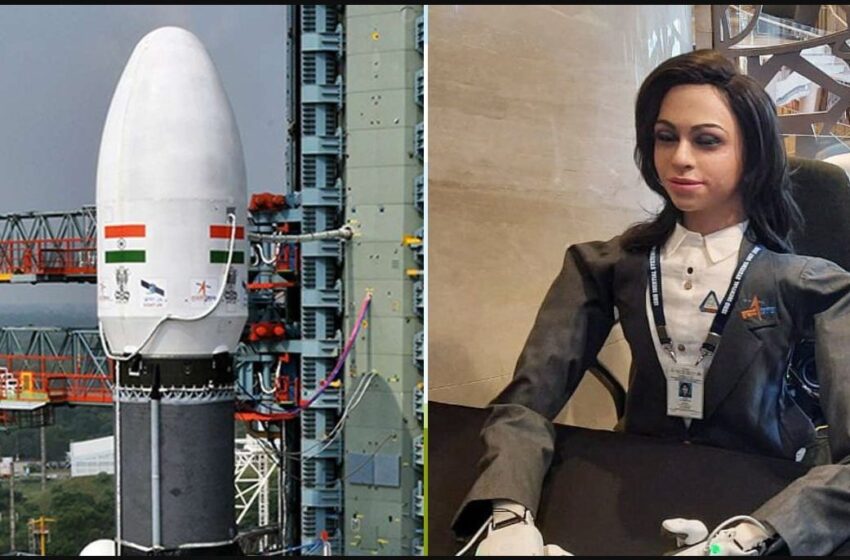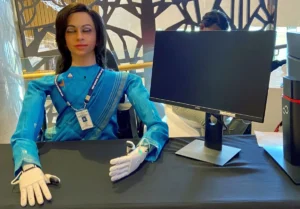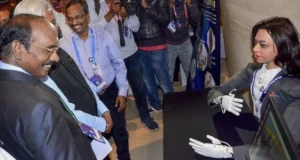UP Board Exam 2026 : Your Complete Guide to Dates, Schedule, and Preparation Tips
Half Humanoid Vyommitra : ISRO’s Space Robot for Gaganyaan Human Spaceflight Mission

Half Humanoid Vyommitra
Half Humanoid Vyommitra : If you’ve been following India’s Gaganyaan mission, you’ve likely heard the buzz around Vyommitra—the “space friend” (from Sanskrit Vyoma for space and Mitra for friend) that’s set to make history. But what exactly is a “half-humanoid,” and why is this robot stealing the spotlight? In this quick deep-dive, we’ll unpack Vyommitra’s design, capabilities, and her starring role in ISRO’s uncrewed Gaganyaan test flight this December. Spoiler: She’s not your average drone; she’s a smart, arm-wielding stand-in for future astronauts.
What Makes Half Humanoid Vyommitra ?
Half Humanoid Vyommitra a is an advanced robotic system developed by the Indian Space Research Organisation (ISRO), specifically for human spaceflight simulations. Unveiled in August 2022, she’s classified as a half-humanoid because she features only the upper body of a humanoid form—think torso, head, and articulated arms—but no legs. This design choice keeps her compact (about 2 meters tall and weighing around 30 kg) and optimized for the tight confines of a spacecraft crew module, where full mobility isn’t needed.

Built primarily from lightweight aluminum alloys, her “skull” weighs just 800 grams, housing cameras for “eyes” and sensors for environmental awareness. At her core is an AI-driven brain that allows her to interact with systems as a human would, making her ideal for testing life-support tech without putting actual crew at risk.
Half Humanoid Vyommitra form draws inspiration from global robotic predecessors like NASA’s Robonaut but emphasizes Indian ingenuity: frugal engineering, rapid prototyping, and integration with local AI startups. She’s not meant to walk on the Moon (yet); her focus is on dexterity and decision-making in zero-gravity.
Key Features and Tech Breakdown
Half Humanoid Vyommitra isn’t just a mannequin with wires—she’s packed with cutting-edge tech to mimic astronaut behaviors. Here’s a snapshot of what she brings to the table:
| Component | Description | Real-World Function |
| AI & Processing | Machine learning algorithms and natural language processing (NLP) | “Understands” voice commands from ground control; simulates human responses to alerts, like adjusting oxygen levels. |
| Sensors & Monitoring | Embedded detectors for temperature, humidity, radiation, and pressure | Tracks cabin environment in real-time; collects data on microgravity effects for post-mission analysis. |
| Articulated Arms | Dual arms with dexterous grippers and multi-joint flexibility | Operates control panels, flips switches, deploys small experiments, and handles emergency protocols autonomously. |
| Communication Suite | High-bandwidth telemetry links | Streams video, sensor data, and status updates to ISRO’s mission control; enables two-way “conversations” via speech synthesis. |
| Power System | Efficient batteries with solar compatibility | Sustains operations for mission duration (up to 7 days in orbit) without heavy energy demands. |
Powered by AI models trained on astronaut training data, Vyommitra can adapt to surprises—like a sudden CO2 spike—by prioritizing tasks or alerting teams. She’s even programmed for basic “empathy,” responding conversationally to keep the vibe steady during long simulations.

Vyommitra’s Mission: Paving the Way for Human Spaceflight
Vyommitra’s debut will be on Gaganyaan’s first uncrewed flight (G1) in December 2025, launching from Sriharikota on an LVM3 rocket. Strapped into the crew module, she’ll orbit Earth at around 400 km for about 5-7 days, testing:
- Life Support Validation: Ensuring oxygen generation, air purification, and waste management work flawlessly.
- Crew Interface Testing: Interacting with avionics as if she were a Gaganyatri (astronaut), spotting UI glitches.
- Emergency Drills: Simulating contingencies like power failures or leaks to refine abort systems.
This data will be crucial for the crewed G3 mission targeted for 2026-2027, carrying India’s first astronauts into low Earth orbit. By handling the “dirty work” of system checks, Half Humanoid Vyommitra reduces risks and costs—true to ISRO’s ethos of doing more with less.
Fun fact: Her name nods to the ancient Hindu sage Mitra, symbolizing companionship. As ISRO Chair Dr. V. Narayanan put it, “Vyommitra is our reliable partner, ensuring our human explorers arrive safe and inspired.”
Why She Matters: A Glimpse into Tomorrow’s Space Exploration
In a world racing toward multi-planetary life, half-humanoids like Vyommitra are the unsung heroes. She represents a shift from brute-force robotics to intelligent companions that can scout harsh environments—be it orbital labs, lunar habitats, or beyond. For India, she’s a proud step in self-reliant space tech, potentially inspiring exports of similar systems to global partners.
Also Read This : World Athletics Championships Tokyo 2025 : Mid-Event Recap and Results
Challenges? Sure—fine-tuning AI for unpredictable space quirks and ensuring arm precision in weightlessness. But with ISRO’s 100% success rate on recent missions, optimism runs high.


